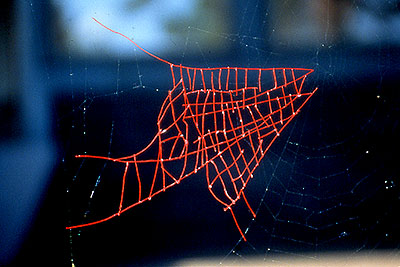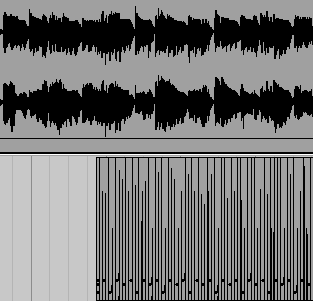View current page
...more recent posts
Another "Greater New York" (2000) alum: Nina Katchadourian

Nina Katchadourian at Debs & Co., New York, NY
by Tom Moody
("Author's cut" of a review originally published in Artforum, Summer 1999)
Nina Katchadourian's recent work, documented in photographs and videotapes, consists of trivial or inept "repairs" to flora and fauna, suggesting the efforts of a clueless amateur field biologist. In Renovated Mushroom (Tip-Top Tire Rubber Patch Kit) (all works 1998), the naturally occurring cracks on mushroom surfaces have been fixed with multicolored tire patches, converting the caps into ridiculous-looking polka-dotted tuffets; in Transplant, a plant's missing leaves have been replaced with membranous insect wings, restoring its symmetry but turning it into a part-animal, part-vegetable monstrosity. Combining the callous experimentation of H. G. Wells's Dr. Moreau with the suburban puttering of Martha Stewart, these projects also send up Andy Goldsworthy's intricate arrangements of rocks and leaves in arcadian settings, which use shamanistic ritual as a pretext for lush photographic set-ups.
Especially reminiscent of Goldsworthy was the "Mended Spiderweb" series, for which Katchadourian sought to restore incomplete areas of large outdoor webs (these were often not the result of any damage but simply gaps in the overall pattern left by the spiders for their own mysterious reasons). Using tweezers and glue, she introduced individual strands of starched bright red thread into a web. The resulting crisscrosses of thick red lines loosely continue the web's pattern, but the photographs make clear that what began as links between interrupted strands often took on lives of their own, seeming to float in the air as "drawings"--semi-abstract, Paul Klee-like pictograms. Mended Spiderweb #8 (Fish-Shaped Patch) really does look like a fish, and certain breaks in the web's network of strands were obviously left "unmended" so that these contours might be retained. Mended Spiderweb #19 (Laundry Line), with its glowing arc of hieroglyphics spanning two webs, features more instances of selective repair. Hovering in gossamer filaments, these thread works are a fragile pas de deux of human and natural effort, so compelling they almost don't need their tongue-in-cheek backstory of "web repair."
Whether one sees them as ironic gestures or exquisite drawings in their own right, the works in this series are tactless invasions of the spider's domain, a fact that Katchadourian readily admits in an accompanying catalogue essay. "I often caused further damage," she writes, "when the tweezers got tangled in the web or when my hands brushed up against it by accident." And while we normally don't know how nature feels about human attempts to "help" it, Katchadourian got immediate feedback. The morning after she made her first patch, she found the threads lying on the ground and realized to her surprise that the spider had pitched them out of the web during the night, like a body rejecting a transplant. This continued to happen with subsequent "repair" jobs, and she eventually succeeded in capturing the rejection process on tape. In the ten-minute video GIFT/GIFT, the viewer watches in amusement as a spider scurries around its web, removing threads as quickly as the artist inserts them. If one sees Katchadourian's project as a kind of New Age-y drawing, then the arachnids become happy collaborators in a cycle of creating and wiping the slate clean; if you take the work ironically, they're environmental "victims" who don't need the help, thanks. It all depends on how you spin it.
Above: Nina Katchadourian, Mended Spiderweb #8 (Fish-Shaped Patch) (detail), 1998, C-print, 20" X 20"

"The Elect Tribe" [mp3 removed].
A catchy Korg drum-and-bass melody interpreted in a dark, psychedelified electro fashion with enthusiastic drumming by a friend's nephew.
Still Emerging After All These Years
With MOMA/PS1's "Greater New York, the Return" we are once again faced with that slippery concept of when an artist "emerges," which leads to oddities such as Scott Grodesky emerging twice in the pages in Artforum, in 1992 and then 12 years later. Why are we faced with this issue? Because "emergence since 2000" and "working in the New York area" are the only stated themes for the show. Important, career launching exhibitions used to have core ideas, reflected in titles such as "Primary Structures," Douglas Crimp's "Pictures," and "The Intrasubjectives"--OK, the latter isn't exactly on anyone's lips but the show included the major AbEx'ers. But since all the powerhouse academics have fled the artworld after using it as a seedbed for pet sociological theories in the '80s and '90s and ultimately killing the soil, and quirky individualism at the curatorial level isn't tolerated in the US anymore for a variety of political reasons, what we get are full time functionaries working in teams, and the only thing they can all agree on is geography and the date.
Yet arguably they botched even the latter, since one could make a strong case that all of the following GNY2005 artists emerged in the '90s and not the 2000-2005 period: Michelle Segre (Elizabeth Koury project room in '93 and Roberta Smith-reviewed two-person show at Lauren Wittels in '96), Randy Wray (solo at Kagan Martos in '96), Meredith Danluck (Andrew Kreps '97), Jason Fox (Feature '99 and group shows starting in '90), Robert Melee (Kreps '98, White Columns White Room '95), Wade Guyton (Kreps project room '99--yes, this one's a squeaker). Corey McCorkle, Steve Mumford, and Sue de Beer were also showing quite a bit in the late '90s. Whether or not the artists had solos or project rooms, all of the above were in group shows and many were written about in not very obscure publications such as Artforum and the New York Times. The upshot of all this isn't that it's unfair for curators to stretch an artist's period of emergence (and I know and/or have written about many of these artists and am happy they're still emerging) but that emergence as a criterion for a major museum exhibit is stupid and should be retired.
